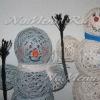We welcome the white month. Russian Buddhists celebrate the New Year according to the lunar calendar. When is the Sagaalgan holiday?
Celebration of Sagaalgan, photo from the website of the Center for the Culture of Indigenous Peoples of the Baikal Region, etno.pribaikal.ru
In general, in the international family of residents of Irkutsk and the region, the New Year according to the lunar calendar is revered and celebrated by many. Sagaalgan - the White Month holiday is a symbol of the renewal of man and nature, and its ideals of peace, good neighborliness, and respect for elders are shared by representatives of all nationalities.
Sagaalgan begins from the first spring new moon. Unlike our usual New Year, which we celebrate at midnight from December 31 to January 1, Sagaalgan begins early in the morning, immediately after sunrise.
On the eve of the white month celebration Buryats clean the house, update their clothes, and get rid of old things. In this way, people seem to say goodbye to the past, to what is gone.
It echoes the Russian customs of celebrating the New Year, doesn’t it? We also generalize, we get rid of the dilapidated, broken, old and unnecessary.
At about 4-5 in the morning, the Buryats are already awake, and at dawn they greet the Sun and the Eternal Blue Sky.
According to legends, it is at dawn, with the rising of the Sun, that the deity, Palden Lhamo, the patroness of Tibet, enters every house and counts everyone who is in the house. It is believed that Lhamo keeps a count of only those people who are awake, who are awake, dressed up and ready to greet a new day. If someone oversleeps, he will not be taken into account by the deity and, accordingly, will miss his luck for the whole year.
Maybe the Russian proverb: “He who gets up early, God gives to him” was born for a reason?
According to the rules of the Sagaalgan meeting You must first introduce yourself to the Sun and thank him for a successful year. Gratitude includes not only warm words of gratitude, but also offerings (treats) for the spirits. It could be milk, sweets, tea, vodka.
Then you need to present all members of your family to the Sun and the Eternal Blue Sky, as well as the spirits that the person worships. Only after that ask for what you want for next year. Basically, this is the well-being of the family and the health of all relatives and friends.

Celebration of Sagaalgan, photo by the administration of the Aginsky district, aginskoe.ru
The shaman, who gave a lecture on the traditions of celebrating the white month, said that the wishes of Buryats in Sagaalgan usually include health for livestock, a good harvest, prosperity for the family business, meeting your soul mate, and the birth of children.
As it turns out, all nationalities have the same dreams.
On the first day of Sagaalgan they don't visit. This day is spent exclusively in the family circle.
Such universal human values as honoring elders and respect for each other, strengthening the family, and introducing young people to the cultural heritage of their ancestors come to the fore. This seemingly simple folk philosophy is passed on by the holiday from generation to generation.
For example, in the ceremony of presenting gifts to each other, the youngest in the family are the first to congratulate and give gifts. That is, children go to their parents, parents to their parents, etc. This is a sign of respect and respect for elders. Parents, having accepted congratulations and gifts from their children, congratulate everyone in return according to seniority, and first congratulate men (boys), and then women (girls).
Importance is attached to the very message of the gift, while its form, high cost, prestige do not matter. In the gift exchange ritual, the main thing is attention.
On the remaining days of the Sagaalgan celebration It is customary to visit guests and treat guests at home. The more guests visit the house during the celebration, and the richer the table, the luckier and more satisfying the coming year will be. 
In the Buryat tradition there is such a rule - never answer the question “how are you?”, “how is life?”, “everything is bad.” For example, when Buryats ask: “How are you?” He must answer that “everything is fine,” or that “everything is going slowly.” But never answer - “everything is bad”, “no money”, “depression”, “bad luck”.
Even if in fact his affairs are not important, he will answer:
- “How are the cattle?”
- “Grows slowly” (even if he has a death).
- “Are cows getting fat?”
- “We have a little, we feed, we try” (even if there was a dry year and there was nothing to feed the cattle).
It’s a good tradition, because thought is material)
In ancient times It was not customary for the Buryats to remember their birthdays, much less celebrate them. With the onset of the White Month, each Buryat added a year to himself. In this case, the year was counted from the year of conception, and not from the year of birth. That is, for example, you are now 30 years old and + a year in your mother’s belly, that is, 31 years old.
Even if you were born on the eve of Sagaalgan, then in ancient times you would have added a year and + a year in the belly, so a month-old baby could be 2 years old.
The same was done with the age of the livestock. All cows, horses, pigs, and rams were given 1 year added with the onset of Sagaalgan.
They say that this custom is still observed in some villages.
Articles about traveling around Buryatia:
*
*
*
When will Sagaalgan be in 2019, how do they prepare for it and how it is celebrated, what traditions are there, as well as 8 Buddhist truths and 4 rituals performed in Sagaalgan.
The Sagaalgan holiday is a symbol of the arrival of spring and the Buddhist New Year. In Russia, Sagaalgan is celebrated in Buryatia, Kalmykia, the Komi and Tyva republics, as well as in the Altai Territory. Sometimes this holiday is called the White Month.
How and when is it customary for Buddhists to celebrate the New Year?
The date for celebrating the Buddhist New Year changes every year. It is determined using the lunar calendar. Most often, the day of Sagaalgan celebration falls on a date between January and March. There are ancient tables to determine the date. Each region has its own, so the dates vary.

The White Month originates from the first spring New Moon. In 2019, the Buddhist New Year falls on February 5th. The Mongolian peoples attach great importance to this holiday. In the Republics mentioned above, the first day of the Sagaalgan celebration is declared a day off.
In Kalmykia, the Buddhist New Year is recognized as a national holiday. It is worth noting that in the Soviet Union it was forbidden to celebrate Sagaalgan. Only after the collapse of the USSR the holiday was revived again. (see for 2019)
Features of Sagaalgan
Sagaalgan, like any new year, is usually celebrated cheerfully, noisily and with close people. On the first day of the holiday, at dawn, the head of the family goes to the yard and asks that his loved ones be happy and healthy. Only after such a ritual is it allowed to begin the celebration.
Friends, family and even neighbors are invited to visit. It is believed that wealth in the coming year depends on the number of people in the house. At the festive table, guests exchange gifts. Buddhists pay special attention to this point. Each participant in the feast receives a gift. No one should be left out.
The owners dream that the first guest to arrive will be a man. It is believed that then everything will be calm in the house and the family will live in abundance next year.

Sagaalgan: history and modernity
The Tsagan Sar holiday has ancient origins. In Russia, for decades after the 1917 revolution, there was an active struggle against the church and faith. In Buryat-Mongolia (modern Buryatia), some traditions and customs were banned. Sagaalgan was also included in this list, since this holiday is a religious one.
Since 1920, it has been prohibited to celebrate the White Month. Those who violated the ban were persecuted and punished. After the end of the Great Patriotic War, local customs and traditions gradually began to revive. But it was officially allowed to celebrate Sagaalgan only in 1990. The Presidium of the Supreme Council of Buryatia issued a decree recognizing it as a national holiday.
The history of Sagaalgan dates back to the 13th century, when Genghis Khan's grandson Kublai Khan issued an order to celebrate the border between spring and winter. After the formation of the Mongol Empire, the Mongols came into contact with a more enlightened and cultural people. They were most influenced by the people of China. They taught the Mongols to use the lunar calendar. According to it, the day of the New Year falls on the first day of spring.
In February in Mongolia and Buryatia there was a period of appearance of offspring in livestock. During this time period, milk was abundant. Not only cattle breeders, but also their guests ate it. An offer to try dairy products sounds like “Sagaalagty”. This is where the name of the holiday came from. Sagaalgan translated means “to taste white food.” Therefore, the month of its celebration is called the White Month.
It is worth noting that in ancient times the Buryats did not remember their birthday. They added a year to their life on the day of Sagaalgan celebration, even if they were born just a month before it. How to remember all the Orthodox events of the coming year? No matter how long you have been a believer, you cannot do without the Orthodox calendar.
Previously, Tsagan Sar was celebrated only in corners of Russia densely populated by Mongols. In the modern world everything is different. The celebration takes place even in the capital of our homeland - Moscow. In 2018, the Great Hall of the Russian Academy of Sciences was allocated for the celebration. According to tradition, a prayer service and feast took place, and the evening was diluted with a concert by the Baikal Song and Dance Theater. It is unknown where the holiday will take place in 2019, but the celebration will be no less large-scale than in past years.

Getting ready for the holiday
Preparation for Sagaalgan occupies a special place in the life of the Mongolian people. There are special rituals and customs. Three days before the celebration, special prayer services are held in datsans (Buddhist temples). The next day, the “Dugjuuba” ritual is performed. It represents cleansing and getting rid of everything unnecessary. The ritual is carried out in several stages:
- Cleaning the house and surrounding area.
- Taking trash out onto the street.
- Dividing the trash into 9 equal parts.
- Laying out all the heaps in one line.
- Setting fire to garbage.
- Lama performing traditional prayers.
At the end of the ritual, people wipe themselves with a piece of dough. It is believed that it takes away all troubles and failures from a person.
On the day before the New Year, the goddess Palden Lhamo is praised. The Mongolian peoples believe that it protects all life on Earth. On the eve of the holiday, the goddess descends from heaven to walk around her domain. House owners and their families must be at home.
Another cleansing ritual is called “Butuu uder”. According to him, on New Year's Eve it is necessary to fast. It is best not to eat anything for 24 hours. It is believed that in this way a person gets rid of all negative emotions (anger, envy, filth). (see in 2019)
Preparations for the holiday end with a gala dinner. In the evening, on the eve of Sagaalgan, guests were invited to the house, a table was set with an amazing variety of dishes. About a dozen lamb dishes are prepared: lamb in broth, several types of blood sausage, buuz and lamb's head. It was served only to the most honored guest. Dairy products included cottage cheese, salamat and cheese. For dessert, it is customary to serve milk foam and cookies fried in boiling oil.
There is also a special attitude towards alcoholic drinks during the celebration. It is not advisable to use them. But for those who wanted to try a little alcohol, they made milk vodka.
Traditions and customs
The first day of the holiday began at dawn. The whole family, led by the owner of the house, went outside and brought offerings to the sun. Afterwards, a sacrifice was made to the spirit of the area. The day before, an altar was erected near each yurt. Family members first walked around him in a circle, then knelt down and prayed.
In the modern world, this custom has been simplified. One man from each family goes to the local obo. There he pays homage to the sun, prays, asks for grace for his family and walks around in a circle. It is also customary to light a fire and smoke incense.
When the man returns home, the celebration begins. Guests are invited to the house, the festive table is set and gifts are prepared. Women are presented with scarves, tea, and scraps of fabric, men are given tobacco or a Buddhist ritual scarf, and children are presented with sweets. On this day it is customary to only relax and celebrate. By tradition, all outfits, tablecloths, dishes on the table and even gifts are chosen in white.
The Buryats have a rule called the “rule of measure and sufficiency.” It means that there must be moderation in everything. You can’t eat your fill or overeat. You are only allowed to buy what you really need. But once a year this rule is allowed to be broken. In Sagaalgan you need to eat your fill and try all the dishes that are on the table.

As I already said, Buddhists attach great importance to whoever enters the house first: a man or a woman. But, much more important than the gender of the guest is what kind of person he is, whether he has a large family, high income, whether he is endowed with intelligence and “happiness” (the ability to make everyone around him happy).
Guests were invited to the table in a certain order. The most honored guests were seated in the northern part of the yurt, with young men to their right and women to their left. The feast always begins the same way. The head of the family uses his knife to cut off a piece of lamb for each guest. The sharpness of a knife indicates how good a master he is. Then, the hostess of the house hands out glasses of milk vodka to the guests. Etiquette obliges guests to drink it or sip a little. Further, it is allowed to refuse alcoholic beverages.
After all the participants in the celebration have eaten to their heart’s content, walking around the yurts begins. First we visited the homes of the oldest family members. Their meeting of guests is called “zolgokh”. The younger guest extends his hands to the owner of the house, palms up, and he places his palms on his hands. It turns out that the young man clasps the old man by the elbows. How to prepare yourself for the Resurrection of Christ and celebrate the main Orthodox holiday. Holiday traditions and the main secrets of the Sacrament.
At the end of the first day, all the residents gathered in the home of the oldest person, sang songs, played games and told fortunes. The old people, based on their own and people’s experience, predicted the weather, the behavior of livestock and the quality of the offspring.
Buddhist New Year Rituals 2019
The Sagaalgan holiday includes many different rituals:
- "Butuulhe." This is a ritual of liberation. People wanted to enter the New Year without obligations, so they rushed to pay off all their debts, made peace with those with whom they had quarreled, prayed and were cleansed of all sins. It is necessary to cleanse not only yourself, but also your home.
- "Burkhan delgeelge." This ritual involves hanging portraits of Deities depicted on canvas around the house. They were presented with various dishes, lamps were placed and incense sticks were lit.
- Hanging out "hiy morina". For the holiday, residents prepared an image of a winged horse, illuminated it in the temple and hung it on a tree or other hill. It was important that it develop in the wind. The winged horse is a symbol of life, protecting all the inhabitants of the yurt from disease and harm.
- "Tabag" ceremony. A pyramid of their sweets (boov) is built on the plate. The number of layers is odd and depends on the age of the person to whom it is dedicated. For example, a three-layer pyramid is dedicated to a 30-year-old family member, and a nine-layer pyramid is dedicated to the nine Deities. The first layer of the pyramid symbolizes happiness, the second - suffering, and the third - happiness again.
There are several Buddhist truths that resemble biblical commandments. They must be followed on the eve of and during Sagaalgan:
- Don't be jealous and don't say bad words.
- Keep your word and always do what you promise.
- Think about every word before you speak it.
- Honor your elders and give them due attention.
- Show concern for your friends and loved ones.
- Thoughts are material, so think only about good things.
- Do the work efficiently so that you don’t have to repent of what you did.
- Help those who are weaker or poorer.
Survey:
Where do you usually celebrate Sagaalgan?
- At home.
- With relatives.
Which part of the holiday do you like best, the feast or walking around the yurts?
- Feast.
- Walking.
December 29. /TASS/. The authors of the tourist project “Fabulous Sagaalgan”, implemented annually in Buryatia on the eve of the New Year according to the lunar calendar, decided to give it a patriotic focus and dedicate it to the Year of Memory and Glory declared in Russia in honor of the 75th anniversary of Victory in the Great Patriotic War. The director of the Tourist Information Center of Buryatia, Chingis Akhanyanov, reported this to TASS on Saturday.
The Year of the Mouse will begin on the night of February 23-24. From February 22 to 24, as part of the “Fairytale Sagaalgan” project, the New Year’s character - the White Elder Sagaan Ubgen and his guests will traditionally participate in the festive program, the theme changes every year.
“This year, the project “Fairytale Sagaalgan” will be dedicated to the Year of Memory and Glory declared by the President of Russia. On February 22 and 23, events related to patriotic education will be held, Sagaan Ubgen will be supported by guests - the Udmurt Father Frost - Tol Babai and the Baikal Father Frost from Irkutsk. On February 24 - this will be the first day of the New Year - the celebration of Sagaalgan in Ulan-Ude will be traditional, according to all canons," Akhanyanov said.
“This is the age when they already suspect that Santa Claus is not real, but continue to believe in him, and at the same time, these children, as a rule, are not as involved in patriotic events as, for example, high school students,” Izailov said. - A special year is coming, when we will all celebrate the 75th anniversary of the Victory, so this theme - the program will include a visit to military units, inspection of military equipment - and Tol Abai from Udmurtia is also not an accident, he will come from Izhevsk - this city is the center of Russia. defense industry".
"Fabulous Sagaalgan"
Russian Buddhists celebrate Sagaalgan - the Eastern New Year - at different times: the date of the holiday is calculated according to the lunar calendar and, as a rule, falls at the end of winter - the beginning of spring.
The “Fabulous Sagaalgan” project in Buryatia was launched in 2007; in 2008, Father Frost from Veliky Ustyug came to visit Sagaan Ubgen. After this, Buryatia on the days of the New Year according to the lunar calendar was visited by the Lord of Cold - Chyskhan from Yakutia, Father Frosts and Snow Maidens from Salekhard, Kostroma, Belarus, Santa Clauses from South Korea, Japan, Finland and other New Year characters from different countries and regions of Russia. By tradition, Sagaan Ubgen receives foreign colleagues at his residence in the Ethnographic Museum of the Peoples of Transbaikalia. The House of the White Elder is made in the form of a large white yurt, around which there are fabulous miles: each of the Santa Clauses leaves his own waymark there.
The coming year has been declared the Year of Memory and Glory in Russia. In Buryatia, the start of the celebration of the 75th anniversary of Victory in the Great Patriotic War was given on December 9, 2019 at the Ulan-Ude Victory Memorial. On December 21, a monument to twice Hero of the Soviet Union, Marshal Konstantin Rokossovsky, who began his path of military glory in Buryatia, was unveiled in the city center.
At the change of year Wooden Goat according to the eastern calendar the year is coming red fire monkey which will begin February 9, 2016- after the completion of the first full cycle of the Moon, counting from the day of the winter solstice. The next Eastern New Year will be celebrated at dawn on the 9th (the beginning of the first day of the lunar month).
The usual cycle of the lunar calendar is 12 years. A full, or Big, cycle is 60 years. It consists of five ordinary cycles of 12 years. Each 12-year cycle is based on a legend. It says that Buddha called all the animals to him before leaving the Earth. However, only 12 of them came to say goodbye to Buddha. Parting with them, the Buddha gave each one a year of reign. The years were given in the exact order in which the animals came running to the Buddha: Rat, Ox, Tiger, Hare, Dragon, Snake, Horse, Sheep, Monkey, Rooster, Dog, Pig.
A big holiday is approaching - Sagaalgan. We bring to your attention the most detailed instructions on how to celebrate this bright day.
As a rule, preparations for the celebration begin among the Mongols long ago, usually a month before the start of the holiday. Dairy foods are prepared for future use - sour cream, aarsa, butter - meat and other products. The property is thoroughly cleaned, and garbage is removed from the yard. Ideal purity symbolizes the purity of a person’s thoughts. Otherwise, deities, creatures from the ten directions and other guests will not enter the house.

Sagaalgan is the birthday of every Mongolian. Remember how we prepare for it. The Mongolian peoples say: how you celebrate the New Year is how you will spend it.
DUGZHUUBA - burning of sins
On the 29th day of the lunar calendar - this year it falls on February 7- is carried out ritual "Dugzhuuba", symbolizing the destruction in fire of the enemies of the faith, and which all Buddhists try to visit.

In the ritual fire "Dugzhuuba" all impurities of the body, speech and mind of every person are burned. To do this, lay people bring with them pieces of dough, cotton wool or paper, with which they first wipe their bodies, after which they throw them in a place where all the rubbish will be burned.
The "Dugzhuuba" ritual is usually held in datsans two days before Sagaalgan. For this ceremony it is made Sor- a tall pyramid of slats, paper and dough, topped with a skull, resembling an arrowhead.
During ritual prayers, the bad karma of the community for the past year is “put into Sor” and then solemnly burned at the stake.
The fight against the enemies of faith, symbolizes and linga ritual: a figurine of a torma is also sculpted for him, personifying evil and enemies of the faith, which is then solemnly cut into 12 parts and burned as a sacrifice offered to the lord of death, Yama.
The day after Dugzhuuba - the thirtieth day of the lunar calendar - the Mandal Shiva khural is held in datsans. The last day of the new year according to the lunar calendar ( February 8) is “closed day” (butuu uder).
Butuu uder
On this day, you need to clean the home altar in a new way, be sure to place offerings to the deities on the shrine in the form meat dish, and also " tabag" - a ritual offering (bread, gingerbread, cookies, bova, candy, refined sugar, marshmallows, etc.), consisting according to the rules of nine floors, which is crowned with a piece of butter. On this day, it is necessary to light zula(lamp), the light of which will illuminate your future path in this and in subsequent lives.

Festive decoration of the yurt.
In "butuu uder" categorically It is prohibited to raise dust in the house- It is necessary to clean the house in advance. Buddhists are recommended to read sacred books, recite mantras, perform prostrations, and do good deeds.
It is highly undesirable to drink alcohol, and you should also refrain from eating meat.
You need to meet Sagaalgan properly prepared for it - with pure thoughts, in a clean place.
Don't sleep through the dawn!
On the first day of Sagaalgan need to get up very early - at 4-5 am. According to legends, early in the morning, before sunrise, a deity enters every house Baldan-Lhamo, which counts all people. Those who oversleep her arrival are considered to miss out on their happiness for a whole year. And those who were awake at this time, on the contrary, will receive the protection of the Buddhist goddess Lhamo, and they will be blessed with good luck and success throughout the year.
After washing your face in the morning, you need to light it zula, smoke sanzai or worse(incense), present tahil(offering) Three Jewels(Buddha, Dharma and Sangha), and offer it on the street sirjam(offering in the form of tea, milk, or vodka) to the deities and owners of the area, splashing on all sides with the words "Om Ah Hum".
After this, Buddhists go to datsan, where they celebrate the White Month holiday together with the clergy.
Visit relatives and hang out Khiy Morin
It is customary to start the first day of Sagaalgan with a walk around the area congratulations to the parents, present to them hadak, gifts. When meeting with elders, you must be neatly dressed and buttoned up.

Present the hadak You need to place your palms up, supporting the older person’s hands from below. In this case, palms facing upward symbolize purity of thoughts, and support by the elbows symbolizes respect for old age and wisdom.
If relatives meet, then one hand remains at the top, and the other hand supports the elbow from below. After the greeting, they step aside, trying not to show their back. Men are on the right side of the house, women are on the left, in order of age. After this, they sit down at the table.
On the holiday, they visit their relatives, friends and acquaintances, thereby strengthening relationships and teaching the younger ones to observe traditions and customs from an early age. When visiting, you must go to the altar and pray, after which you can, at the invitation of the hosts, go to the festive table.

During the days of Sagaalgan, usually on the second day according to the lunar calendar, takes place ritual of "launching the horse of the winds"- using the image of the “horse of the winds” ( Hi Morin), consecrated by the lama.
"Khiy Morin" is tied to a tree or placed on the roof of a house so that it flutters in the wind.
It is believed that the “horse of the winds” serves as a powerful protection against misfortunes and illnesses, attracting the attention of higher beings and calling on the help of deities. His image also symbolizes wishes for health, happiness and prosperity in the new year to all living beings.
Almost the whole world is accustomed to celebrating the New Year on the night of December 31 to January 1. As a rule, it is celebrated with family or friends, they decorate a Christmas tree, set a large festive table and wait for midnight, when one year gives way to another. However, some peoples of the world historically celebrated it at a completely different time and even now, in addition to the calendar holiday, they celebrate their national New Year.
How and when the indigenous peoples of Buryatia celebrate the change of year, the AiF-Buryatia correspondent looked into it.
When a birch leaf blooms
The summer holiday of Ikenipke can be considered the Evenki New Year holiday. As I told you Nadezhda Shemetova, head of the state republican center of Evenki culture “Arun”, it comes at the end of spring - beginning of summer, when birch leaves bloom on the lands where the Evenks have lived for centuries. It marks the awakening of nature, and its renewal becomes the starting point of the New Year. On this day, traditional rituals are held, and the Spirits are presented with treats - sweets, cooked meat, bread, milk and other products.
There are no holidays for the Evenks on the dates of the calendar new year, as well as in December and January. The closest to them is the November festival of the first snow. The image of Tugeni Enyoken - Mother Winter - has always been associated with him: a beautiful mature woman dressed in a traditional Evenki outfit trimmed with white fur. It was connected primarily not with people, but with nature. The time when the first snow covered the ground and Tugeni Enyoken came into its own was considered a holiday, as well as the best time for hunting.
Now the image of Tugeni Enyoken has a new interpretation. “In the last 15-20 years, the arrival of Mother Winter has become associated not only with the holiday of the first snow, but also with the calendar New Year,” says Nadezhda Egorovna. “To some extent, the use of her image these days is artificial, because historically she was not associated with it.” However, the children of Tugeni really fell in love with Enyoken, and now she appears at the holiday, not replacing Father Frost and the Snow Maiden, but as a third, purely Evenki character. She plays games with the children, asks them riddles and treats them with sweets.
"White Month", Buddhism and Shamanism
Buryatia is a region in which two religions - shamanism and Buddhism - not only get along, but also intertwine so that common holidays appear. These include the most important Buryat holiday - Sagaalgan or “White Moon Holiday”.
Before the advent of Buddhism, the Buryats celebrated it on the day of the autumn equinox - September 22 or 23. However, the grandson of Genghis Khan, Kublai Khan, under the influence of the new religion, moved the holiday to the end of February - beginning of March, that is, to the New Year according to the lunar calendar. Sagaalgan marks its beginning, and the “white month” is the first, “clean” month of the coming year. It is considered primarily a family holiday. At this time, a ceremony is held to honor the elders, the younger ones give them gifts, and the elders then go to the elders and give them gifts.By the way, Sagaalgan begins not at midnight, but at sunrise. The day before, the house is cleaned and unnecessary things are removed. It is interesting that historically the Buryats even began to count age only after the “white month” had arrived.
Do the Buryats have Santa Claus?
The White Elder Sagaan Ubgen is considered an analogue of the usual New Year's grandfather with gifts in Buryatia. But still, he is not Santa Claus, but a religious character. Even before the advent of Buddhism, he was considered the patron of longevity, wealth, happiness, family well-being, procreation and fertility. Sagan Ubgen commanded wild animals, domestic animals and even people, and was also the ruler of mountains, earth and water. According to legend, when he appears, he brings peace, tranquility and balance to the lives of those who revere him.
Previously, the Mongolian peoples - and not only the Buryats revere the White Old Man - depicted him as a hermit with a white beard, dressed in white clothes and holding in his hands a staff with the head of a dragon. Over the long centuries, Sagan Ubgen has changed: now the old man is still dressed in white clothes, but in winter - a fur hat and a white fur coat with stylized Buryat patterns.
You can meet the White Elder only once a year - in Sagaalgan. His residence on this day is located in a large yurt of the ethnographic museum of the peoples of Transbaikalia. In addition, she appears on the central square of Ulan-Ude during the celebration of the arrival of the “white month”. Although he is not Santa Claus, children perceive him as such and expect gifts from him, so he carries a small bag of sweets with him.Read also...
- Russian Buddhists celebrate the New Year according to the lunar calendar. When is the Sagaalgan holiday?
- Big Kinder Surprise with your own hands How to make a Kinder surprise from chocolate
- How to give yourself a short haircut
- Original hairstyles with elastic bands for girls Easy hairstyles with small elastic bands



















